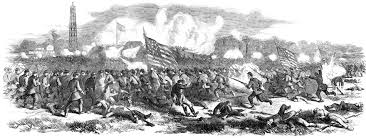 |
 |
Indexes to Probate Records
Maps
Miscellaneous
The Battle of Tarrar Springs
 Battle of Tarrar Springs. Lexington is known for the Battle of Tarrar Springs which was fought during the Revolutionary War on November 16, 1781. After the war, Lexington County was established (1785), with the township of Saxe Gotha renamed to Lexington. The first courthouse was built at Granby, located just south of present day Cayce. From 1800 to 1868, the county was organized as a district with the same name.
Battle of Tarrar Springs. Lexington is known for the Battle of Tarrar Springs which was fought during the Revolutionary War on November 16, 1781. After the war, Lexington County was established (1785), with the township of Saxe Gotha renamed to Lexington. The first courthouse was built at Granby, located just south of present day Cayce. From 1800 to 1868, the county was organized as a district with the same name.

Lexington County Probate Records
The First Settlers to Lexington County : Saxe Gotha Township
The township of Saxe Gotha, named after the Dukes of Saxe Gotha whose territories were in Bavaria and Thuringia, Germany was established in 1737 when Rev. Riemensperger, who first brought immigrants from Switzerland and Germany and settled them in Orangeburg in 1733, returned to Switzerland in 1737 for more immigrants. He returned again to Switzerland in 1740 and 1748 and brought 600 Palatines and Wurttembergers to the township. Other immigration agents brought 1500 Germans, so by 1750 both Saxe-Gotha Township and the area to the northeast (Dutch Fork) were populated with German-speaking small farmers and redemptioners (indentured servants). During the Revolutionary War many sided with the British out of fear that their land grants would be rescinded.
Three years later a pamphlet dated 1740 in St. Gall was published concerning the settlers. "All persons who are adherents of the Evangelical Reformed religion, should settle in this country, and can expect all that has been promised above, but the Roman Catholics must stay away." Signed the folllowing settlers: Hans Jacob Riemensperger, Casper Justzler, Rudolph Capeler, Heinrich Geiger, Abraham Geiger, Joh. Henrich Weber, Jacob Fritig, Hans Straub, Hans Casper Galliser, Jacob Hagenbuch, Hans Jacob Geiger, Hans Heini Gallmann Antoni Steck, Jacob Liffer, Daniel Schneider, Heinrich Gallmann, Joseph Crell, Hans Gallman, Ulrich Puser, Hans Casper Frey, William Becker, Johan Matheis, Hans Jacob Steiner, Ulrich Sperling, Hans Buss. Most, perhaps all, came from Tuggenburg district of the Canton of St. Gall.
In 1741 the news of the erection of this township reached the Lutheran pastors at Ebenezer, who wrote in their diary, under date of December 2, 1741: "We had heard nothing before of Saxe Gotha in America, but we have just received the intelligence that such a town is laid out in South Carolina, 100 English miles (or 25 German miles) from Charles Town, on the road which passes through Orangeburg, and is settled with German people. Doubless the majority of them are Reformed people, because they have a Reformed minister among them, with whose character we are not yet acquainted." Source: Urlsperger Reports Vol. II,p.1791.
In December 1741, the Lutheran ministers report the arrival of another colony of Swiss.
In 1750, the Lutheran pastors refer to this settlement: " "The German Evangelical Lutheran inhabitants of Congaree, in South Carolina, which new settlement has been named Saxe-Gotha, besought me, several months ago, to come to them and preach for them, and administer the Lord's Supper...The Reformed have received 500 pounds Carolina currency from the government (which amount is something more than 500 guilders) for the building of a church, but no one is interested for the Lutherans, unless I would do something in their behalf. They live with the Reformed in great disunion, at which I showed my displeasure in my former letter...The citizens themselves, as a Carolina minister once wrote me, live disorderly among each other and estimate their Reformed minister very low."
In 1757 Saxe Gotha had 66 families, and some settlers had moved across the Congaree River to obtain better lands on the north bank in what is present-day Richland County. In 1768 the Royal Colony of SC passed the District Act and Saxe-Gotha became part of Orangeburg District and within the newly established St. Matthew's Parish.



Battle of Tarrar Springs. Lexington is known for the Battle of Tarrar Springs which was fought during the Revolutionary War on November 16, 1781. After the war, Lexington County was established (1785), with the township of Saxe Gotha renamed to Lexington. The first courthouse was built at Granby, located just south of present day Cayce. From 1800 to 1868, the county was organized as a district with the same name.
